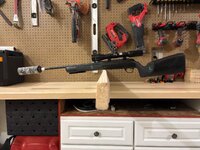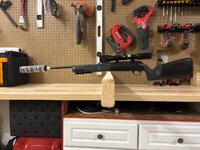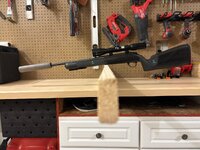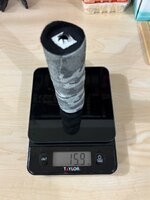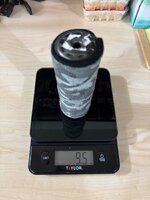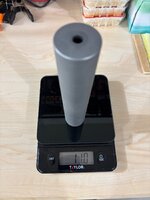Man that was sneaky.Try not to ting about it (I'll see myself out)
Sent from my SM-S918U using Tapatalk
Navigation
Install the app
How to install the app on iOS
Follow along with the video below to see how to install our site as a web app on your home screen.
Note: This feature may not be available in some browsers.
More options
Style variation
You are using an out of date browser. It may not display this or other websites correctly.
You should upgrade or use an alternative browser.
You should upgrade or use an alternative browser.
Unknown suppressors OG testing
- Thread starter Dioni A
- Start date
Because trying to use logic and reason with a Texan is a bad idea because you all think you know everything already. You aren't buying one so why are you even in this discussion?Why would you say that?
Sent from my SM-S918U using Tapatalk
Perhaps you should do your own calibrated acoustics test and post the results. We would all like to see what you come up with.Good job, getting some measurements!
I do have some setup questions though, as the true peak might be underestimated by the settings. Or the test setup could make the measurements worse.
- Sampling rate and pk rise time?
- What mic?
- Precision Class?
- Calibrate before and after, by any chance?
- Did Lpk really use A-weighting and Fast time response?
- Does the Impulse response work?
- All measurements done w/meter resting on the case? Where was the shooter?
- Acoustic free field? Sorta kinda looks like it, but not enough shown.
- Measurement with no muzzle device, by any chance?
Hate to put you on the spot, but those affect the results and how they should be interpreted. I've never used that meter and don't recognize the brand.
And as you may know, many meters underestimate impulse peaks to begin with, compared to a full blown analyzer/DAQ.
Sent from my SM-S918U using Tapatalk
They posted multiple videos on their social media accounts of their destructive testing. Including boring it out to .338 and shooting it with 118 grains of powder on a 33XC. Have yet to see a Scythe do that.... or any other manufacturer. The data and videos have been out there, you just didn't see them.This thread simply baffles me. People post here asking further questions and clearly looking to discuss the product’s merits and the responses range from passive aggressive to outright hostile.
I pre-ordered the OG despite this forum. I think some people need to take a look at what isn’t posted on the US website.

The OG - The Ultimate Hunting Suppressor
The OG is the embodiment of “Chasing Tones, not Decibels”. Tone really is what matters when it comes to a hunting suppressor. That is where the OG shines.unknownsuppressors.com
It looks like any other suppressor manufacturer’s website.
Now look at everything US puts on the website about the rigorous testing process:

Not one mention of how the tests were conducted. No links to pictures, videos, etc. not even a link to the podcasts discussing it. The website is the same kind of bland reassurance as every other suppressor manufacturer’s website. It comes down to “trust us, bro.”
If you only want to market to people who spend all their time on this forum, that is a choice. But when people go looking for the testing methodology, there’s no stickied links to any of this stuff. People are trying to buy a product. Make it easy.
____________________
“Keep on keepin’ on…”
Sent from my SM-S918U using Tapatalk
JGRaider
WKR
You obviously know a fraction of what you think you know, but whatever.Because trying to use logic and reason with a Texan is a bad idea because you all think you know everything already. You aren't buying one so why are you even in this discussion?
Sent from my SM-S918U using Tapatalk
- Joined
- Jan 5, 2012
- Messages
- 9,705
Sent from my iPhone using Tapatalk Pro
Lawnboi
WKR
Any plans on having silencershop stock any? Would be waiting for a larger barrel option anyways.
My local charges 160$ for a transfer.
My local charges 160$ for a transfer.
If you don’t understand how barriers to entry inhibit competition and inflate prices for consumers, I don’t know what to tell you.
Hearing safe suppressors don’t have to cost $1000. Yes, a titanium hunting can might still be $1000. But I fully expect a lot more cheap suppressors on the market if they become less regulated. And the instant someone wants to take some market share, they can offer a similar product at $950. Over time, many current producers will go out of business to more efficient places. And new ones will enter the market.
I am just guessing, but I imagine that many of these places are making a healthy profit on the cans they currently sell. People expecting to wait months or years for a suppressor don’t mind waiting a month or two for some small shop to sell them. These are niche items right now. The shops aren’t really efficient. Increased sales volume will drive efficiency.
Aluminum and steel suppressors are very common in other countries. That’s a lot easier for anyone to manufacture, a lot cheaper, and I fully expect to see not only DIY types, but lots of small places making them. The technology to make a hearing safe can just isn’t that complicated. A kid could do it in shop class, if it wasn’t illegal. It wouldn’t surprise me at all to see steel cans, perfectly suitable for the range, in the $300 range.
In a few years after deregulation, buying a suppressor will be like buying a spare magazine or a new stock or an optic or any other rifle part. Those worth a premium will still be expensive, but only as long as they are worth a premium. And the better cans will tend to be slightly cheaper than they are now.
____________________
“Keep on keepin’ on…”
I believe every suppressor sold currently requires a $200 stamp. How is that a barrier to inhibiting competition with other sellers? If a company is able to produce a can and sell it for $300, they can. If a company sells one for $1000, they can; it's up to me to decide which one I want to go with.
I have no knowledge of the profit margins of companies, but my first suppressor was purchased 20 years ago, and it cost over $800 at the time. The company currently sells a similar one for over $900. I have no doubt they are making a profit because they wouldn't be in business if they didn't.
Aluminum and steel construction are still common in the US. I think hunters have driven the market for lightweight titanium cans, which is a positive development.
I would love to see them deregulated and treated like an accessory, but I have my doubts that we will see a significant shift in manufacturers making them for less money and producing a product that will last more than one trip to the range. Hope I am wrong.
HuntHarder
WKR
Time will tell, but i think you may be wrong @mtnbound
The ability to have a secondary market, as well as more competition, *should lower the overall price. I agree with most, that the near term might be chaos with shortages and price spikes. Long term, I expect prices to fall.
Back on topic.. I will compare my OG to my Scythe and Gemtech and post an honest review. I have been really happy with my Scythe, even tho some say they are junk.. In my comparisons, I'd take it over a bunch of others. Then again, mine hasn't blown up...... yet.

The ability to have a secondary market, as well as more competition, *should lower the overall price. I agree with most, that the near term might be chaos with shortages and price spikes. Long term, I expect prices to fall.
Back on topic.. I will compare my OG to my Scythe and Gemtech and post an honest review. I have been really happy with my Scythe, even tho some say they are junk.. In my comparisons, I'd take it over a bunch of others. Then again, mine hasn't blown up...... yet.
- Joined
- May 8, 2022
- Messages
- 722
Did my best to measure balance point with the suppressors available to me. I initially tried a rounded trekking pole but couldn’t get them to balance consistently. Using a 1x2 was the next best option I could come up with.
The photos hopefully tell the story well enough. To summarize, the Scythe and the OG balance almost identical even though the OG is 1.5 oz heavier. The much heavier harvester evo pushed the balance point further out. That said, in hand the OG definitely feels more svelte thanks to its smaller diameter and I really do feel like it balances better and points nicer even though the balance point seems to be identical.
The photos hopefully tell the story well enough. To summarize, the Scythe and the OG balance almost identical even though the OG is 1.5 oz heavier. The much heavier harvester evo pushed the balance point further out. That said, in hand the OG definitely feels more svelte thanks to its smaller diameter and I really do feel like it balances better and points nicer even though the balance point seems to be identical.
Attachments
RockAndSage
WKR
Reduced regulations leads to increased supply which leads to decreased costs. Economics 101
Reduced regulations lead to decreased consumer cost, which lead to increased demand, which leads to decreased supply, which leads to increased prices until supply-side elasticity catches up. Economics 101.
- Joined
- May 8, 2022
- Messages
- 722
Respectfully, could all of you discussing the economic implications of supressors being delisted consider starting a new thread or piggy back on one of the multiple threads already discussing what may happen if they get delisted?
Ironically, to those saying it’s hard to find good information about this suppressor and saying they don’t have the time to read through the thread, all the banter about suppressor economics is just perpetuating the problem.
It would be nice to keep this thread focused on the OG, especially as production models begin to find their way into the wild.
Ironically, to those saying it’s hard to find good information about this suppressor and saying they don’t have the time to read through the thread, all the banter about suppressor economics is just perpetuating the problem.
It would be nice to keep this thread focused on the OG, especially as production models begin to find their way into the wild.
wind gypsy
"DADDY"
- Joined
- Dec 30, 2014
- Messages
- 12,711
All this balance talk and it balances the same place as a scythe.
Frankly, I’d take further forward balance. Hand carry in front of the (protruding) tikka mags and the balance point for a front rest isn’t on top of the protruding bottom metal.
I’d like the shorter OAL for sure but the pointing and balance stuff seems a bit much.
Frankly, I’d take further forward balance. Hand carry in front of the (protruding) tikka mags and the balance point for a front rest isn’t on top of the protruding bottom metal.
I’d like the shorter OAL for sure but the pointing and balance stuff seems a bit much.
- Joined
- May 8, 2022
- Messages
- 722
Frankly, I’d take further forward balance. Hand carry in front of the (protruding) tikka mags and the balance point for a front rest isn’t on top of the protruding bottom metal.
In regards to this specific statement, I think that depends on how you use your rifle. Shooting mostly supported positions, such as stand hunting or bipod/tripod I’m inclined to agree.
However, when trying the hunting rifle drill and doing some offhand shooting, I found I had a smaller wobble zone with the OG and my hit rate did improve with offhand shots as a result. If I was carrying the gun and anticipated the potential for a quick offhand or minimally supported shot, the balance and ease of pointing to target would be a big benefit in my opinion.
Obviously I want to see the OG do well and want to see US be successful but I’m still doing my best to be unbiased and share what I’m observing in my use of the demo model.
It seems to me some think we are trying to point out why the OG is better than X, Y, Z suppressor but in my opinion it’s much more about showing how it differs from other supressors and why that may be a pro or con depending on your use case.
Hurley88
Lil-Rokslider
- Joined
- Dec 11, 2022
- Messages
- 184
I made an anccount and ordered during the early sale, so hopefully soon it’ll be on its way. This will be my first suppressor.
Last year I shot with a bunch of brakes & suppressors out of curiosity; I quickly decided I cannot stand brakes. But I equally can’t stand long barrels for hunting. When I was trying out suppressors (where I shoot they have loaners), I got to experience the problems. Shooting loose, mirage, covers slipping, burning my hand…at the time I thought it would be better to just pop in my earplugs while hunting like I’ve been doing my whole life; I just wasn’t impresssd. At the range, shooting unsuppressed with earmuffs doesn’t bother me in the slightest, especially since I shoot smaller cartridges now. Big PRS crowd there, a lot of them are running brakes so they’re the jerks not me haha. And I’m the guy with tinnitus.
Then I started coming across all the firsthand stories of the benefits to suppressors. Game sticking around longer, not having the extra step of donning earpro…and the big one now that I hunt in a group half the time is being able to talk through shots. Still, I just couldn’t buy one bc I couldn’t stand the extra length or troubles. I’ve been staying back, bc for me the downsides outweighed the benefits.
Fast-forward to the present. Soon I’ll have a 16” barreled 6CM with the OG suppressor. Same length as all my 20” hunting rifles, hearing safe, same balance & handiness…but with all the benefits of hunting suppressed. I’m to the moon, can’t wait.
Just wanted to throw that out there as a counterpoint to all the comments from guys wondering “what does this suppressor offer?” Simple. It’s the best balance of attributes I’ve seen for the hunter. It’s hearing safe (but not the absolute quietest) while adding less length to your barrel than other hearing safe options. It’s also on the lighter end of the spectrum for options at this level of suppression, especially considering that the weight is moved further back.
Love/hate Form, love/hate Rokslide, take issue with the ease of accessing info…all that aside, this is one helluva option for suppressed rifles and finally tipped the scales for me. I’d say they knocked it out of the park.
Last year I shot with a bunch of brakes & suppressors out of curiosity; I quickly decided I cannot stand brakes. But I equally can’t stand long barrels for hunting. When I was trying out suppressors (where I shoot they have loaners), I got to experience the problems. Shooting loose, mirage, covers slipping, burning my hand…at the time I thought it would be better to just pop in my earplugs while hunting like I’ve been doing my whole life; I just wasn’t impresssd. At the range, shooting unsuppressed with earmuffs doesn’t bother me in the slightest, especially since I shoot smaller cartridges now. Big PRS crowd there, a lot of them are running brakes so they’re the jerks not me haha. And I’m the guy with tinnitus.
Then I started coming across all the firsthand stories of the benefits to suppressors. Game sticking around longer, not having the extra step of donning earpro…and the big one now that I hunt in a group half the time is being able to talk through shots. Still, I just couldn’t buy one bc I couldn’t stand the extra length or troubles. I’ve been staying back, bc for me the downsides outweighed the benefits.
Fast-forward to the present. Soon I’ll have a 16” barreled 6CM with the OG suppressor. Same length as all my 20” hunting rifles, hearing safe, same balance & handiness…but with all the benefits of hunting suppressed. I’m to the moon, can’t wait.
Just wanted to throw that out there as a counterpoint to all the comments from guys wondering “what does this suppressor offer?” Simple. It’s the best balance of attributes I’ve seen for the hunter. It’s hearing safe (but not the absolute quietest) while adding less length to your barrel than other hearing safe options. It’s also on the lighter end of the spectrum for options at this level of suppression, especially considering that the weight is moved further back.
Love/hate Form, love/hate Rokslide, take issue with the ease of accessing info…all that aside, this is one helluva option for suppressed rifles and finally tipped the scales for me. I’d say they knocked it out of the park.
5811
WKR
- Joined
- Jan 25, 2023
- Messages
- 1,000
Nicely done, thanks! This is pretty much exactly what I was looking for.Did my best to measure balance point with the suppressors available to me. I initially tried a rounded trekking pole but couldn’t get them to balance consistently. Using a 1x2 was the next best option I could come up with.
The photos hopefully tell the story well enough. To summarize, the Scythe and the OG balance almost identical even though the OG is 1.5 oz heavier. The much heavier harvester evo pushed the balance point further out. That said, in hand the OG definitely feels more svelte thanks to its smaller diameter and I really do feel like it balances better and points nicer even though the balance point seems to be identical.
I wasn't sure what to expect for a result, so very interesting to see. It also shows how a small change in balance point can have a big impact on feel. I know that Evo feels noticeably different than the scythe, but only an inch or a little more forward for the balance point.
Are the relative values useful if the settings were not adjusted between tested cans? Many of us have a signature in mind from first hand experience with the chosen comparison cans.
-J
J,
That's a good question, regarding the meter used, mic selected, and settings. Without knowing the details of the equipment, we'd just be guessing.
However, appropriate mics are expensive and sometimes called a "pressure mic". They are not typically included with generic SLM (sound level meter) kits. It's a specialized device.
Assuming a standard mic was used, it is likely that the dynamic range of the mic has been pushed which can affect the readings.
Think about weighing something... you don't use a truck scale to weigh a bag of dog food. But could you? Sure! But it's not the right tool.
Noise measurements are no different - use the right tool for the job.
The other parameters, like rise time might not make a huge difference but sampling rate can. The peak reading is very short duration, and that meter no matter what mic was used would more than likely underestimate the true peak.
Would it underestimate the true peak for each silencer tested? Probably, but you can imagine how one can's measurement might have occurred just before the true peak, and another just after the true peak. But... how far off from the true peak for each one?!
There are ways to somewhat mitigate this, or at least do a gut check, but that's TMI for this thread.
Regarding the A-weighting: it's not completely 1:1, but rather weighted to reflect the response of the human ear. There are better weightings available so that the value is not manipulated. That stated, the peaks are likely in the flat region for A-weight.
That SLM can supposedly run dual SLM simultaneously, so one could use appropriate settings and also use some bogus settings to compare the readings. To check the validity of the SLM as a whole, you'd do side-by-side tests. And you could use an appropriate pressure mic with splitter to the SLM in question and another cable to a real analyzer/DAQ.
There's more, but that's the gist. Feel free to shoot me a PM if you have questions.
PS - I have discussed doing tests at the shooter's ear with a couple dealers over the years, but in the end neither party is super motivated.
It may sound strange, since I have the equipment and basic knowledge to run the tests, but I am in agreement with some of what has been posted above - you're still going to wear in/over ear protection at the range. And when hunting you're just taking a few shots. Limited scenarios are truly hearing safe for extended sessions. I just want the noise reduced for hunting, when I do not have ear protection. Plus, the dealers sell cans just fine without any test results, and there are bigger fish to fry than standard screw-on silencers for my interests. Pew Guy sells his services and data for those that want comparisons.
Just pick the can you like, and rock on. If balance is your thing, great. Some want full-auto rating as they move the can around to different rifles like an AR platform. That's cool too.
My only advice is to just be cautious with the reported values. At least one mfg doesn't list them, and others are likely underestimating the true peak based on their equipment, set up, etc.
Where it can get interesting, are particular shooting positions that can affect the noise at the shooter, or claims of particular tones (Healing Tones!). Psychoacoustics for tones gets more complicated than simple noise measurements, and there's nothing you can do about the bullet creating a "supersonic crack" which can also be damaging. The supersonic crack outweighs tones, for me, but everyone has their own opinions.
Still, I went to a local dealer to see if they had any OG on order. The buyer never heard of the OG or Unknown, so they looked it up in the system/kiosk - neither showed up.
As stated earlier, if I come across an OG, I'll test it and send the results to the owner of the business before posting anything on a public forum. That goes for any can.
It may sound strange, since I have the equipment and basic knowledge to run the tests, but I am in agreement with some of what has been posted above - you're still going to wear in/over ear protection at the range. And when hunting you're just taking a few shots. Limited scenarios are truly hearing safe for extended sessions. I just want the noise reduced for hunting, when I do not have ear protection. Plus, the dealers sell cans just fine without any test results, and there are bigger fish to fry than standard screw-on silencers for my interests. Pew Guy sells his services and data for those that want comparisons.
Just pick the can you like, and rock on. If balance is your thing, great. Some want full-auto rating as they move the can around to different rifles like an AR platform. That's cool too.
My only advice is to just be cautious with the reported values. At least one mfg doesn't list them, and others are likely underestimating the true peak based on their equipment, set up, etc.
Where it can get interesting, are particular shooting positions that can affect the noise at the shooter, or claims of particular tones (Healing Tones!). Psychoacoustics for tones gets more complicated than simple noise measurements, and there's nothing you can do about the bullet creating a "supersonic crack" which can also be damaging. The supersonic crack outweighs tones, for me, but everyone has their own opinions.
Still, I went to a local dealer to see if they had any OG on order. The buyer never heard of the OG or Unknown, so they looked it up in the system/kiosk - neither showed up.
As stated earlier, if I come across an OG, I'll test it and send the results to the owner of the business before posting anything on a public forum. That goes for any can.
JGRaider
WKR
Wind speed and direction can obviously play with perceived loudness, crack, etc. Bunch of variables.
Hurley88
Lil-Rokslider
- Joined
- Dec 11, 2022
- Messages
- 184
When mine comes in I’ll do a comparison with the other loaner suppressors at the place I shoot. I got one guy that works there pretty interested in it so he’s on board. I’ll post up our thoughts, his will be worth more than mine though bc he uses lots of suppressors.
I’ll put at least 100 rounds in mine first so it isn’t dry vs heavily used.
I’ll put at least 100 rounds in mine first so it isn’t dry vs heavily used.
Similar threads
- Replies
- 0
- Views
- 397
- Replies
- 6
- Views
- 750
Featured Video
Latest Articles
- TT#64 Josh Boyd Elk Hunting Strategies for Every Season
- Aaron Davidson of Gunwerks
- TT#63 Dirk Durham’s Art of Elk Calling
- BIG Buck Stories with the Dirty Giants Podcast
- TT#62 Brian Barney Hunting Bulls without Calling
- Hoyt Alpha AX-2 SD Review
- Kuiu Kenai vs Outdoor Vitals Vario Hooded Jacket Review
- Hoyt RX-9 Ultra Review
- Hunting Vampire Bucks & Building an Optics Kit
- Darton Sequel ST2 35 Review


